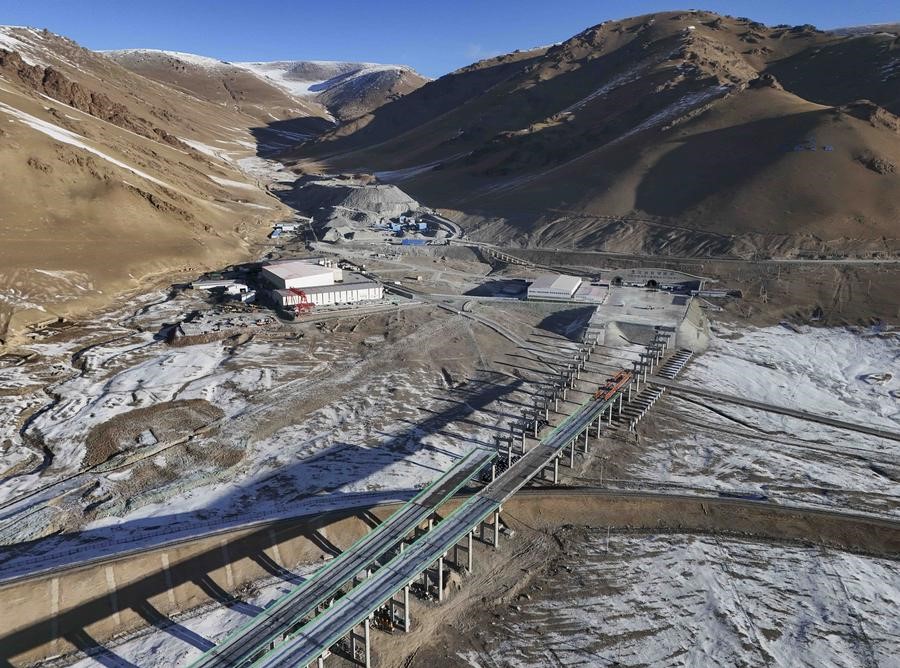
 0 Comment(s)
0 Comment(s) Print
Print E-mail Xinhua, December 31, 2024
E-mail Xinhua, December 31, 2024
A drone photo taken on Dec. 25, 2024 shows the exit of the Tianshan Shengli Tunnel in Hejing County of Mongolian Autonomous Prefecture of Bayingolin, northwest China's Xinjiang Uygur Autonomous Region. [Photo/Xinhua]
The Tianshan Shengli Tunnel, the world's longest expressway tunnel, completed tunneling Monday morning, paving the way for the opening of a new shortcut linking southern and northern parts of China's Xinjiang Uygur Autonomous Region.
The 22.13-kilometer tunnel will reduce the time it takes to drive across the middle section of the Tianshan Mountains from several hours to about 20 minutes once operational.
It is a key project of the Urumqi-Yuli Expressway, which runs from the regional capital of Urumqi in northern Xinjiang to Yuli County in southern Xinjiang. The expressway is expected to be fully completed and open to traffic in 2025. The driving time between the two locations will be reduced from about seven hours to just over three hours.
Shortcut connecting north and south
Covering one-sixth of China's total land area, Xinjiang is divided into northern Xinjiang and southern Xinjiang by the Tianshan Mountains, stretching over 2,500 kilometers from east to west and forming a formidable natural barrier.
Qadir Abliz, a truck driver from Urumqi who makes regular trips between the north and south of the Tianshan Mountains, said the winding mountain roads would often freeze in the winter, and many trucks carrying coal, agricultural produce and livestock products would be stranded on the way across.
"There will be no need to worry about such situations anymore when the tunnel opens next year," he said.
Baye, a herdsman whose family has lived near the tunnel at the foot of the Tianshan Mountains for generations, has a deep connection with this project.
"I really hope it opens to traffic soon! In the past, when a family member had an emergency, and we needed to go to northern Xinjiang for medical treatment, we would drive up the mountain and might encounter road closures due to heavy snow at altitudes above 3,000 meters," said Baye.
The Tianshan Shengli Tunnel stands as a landmark project showcasing China's unwavering commitment to improving people's well-being through transportation development, according to Li Zhicui, a professor at the Business School of Xinjiang Normal University.
"The tunnel will serve as a key tourism corridor and enhance the market competitiveness of local products by making transportation faster and cheaper, thus playing a vital role in driving regional economic development," said Li.
In addition, the tunnel will significantly improve communication between the north and the south, fostering closer ties among ethnic groups and promoting balanced regional growth, according to Li.
Overcome mountainous challenges
Since the 1950s, China has worked to connect northern and southern Xinjiang with roads such as the Urumqi-Korla and Dushanzi-Kuqa highways. However, rapid economic and social development, along with the growing needs for transportation, have outpaced the capacity of these routes.
Over the past decade, Xinjiang has invested heavily in building transportation infrastructure, improving its network of highways, railways, airports, and logistics hubs to support its role as the core area of the Silk Road Economic Belt.
"Xinjiang has entered a period featuring unprecedented investment scale and development speed," said Zheng Mingquan, deputy director of the regional administration of transportation law enforcement.
The new tunnel, whose construction began in April 2020, is no small feat. It has faced multiple challenges, such as extreme cold, high altitudes, high ground stress, strong seismic activity and strict environmental requirements, according to Mao Jinbo, an engineer on the project.
The Tianshan Mountains are known as a "geological museum," featuring numerous fault zones, 16 of which the tunnel passes through. Its No. 2 ventilation shaft reaches a depth of 706 meters -- taller than China's highest building, the Shanghai Tower.
The builders broke down construction into smaller, more manageable segments and employed domestically-designed hard rock tunnel boring machines, developed using innovative pressure injection methods. As a result, the original construction timeline was shortened by more than 25 percent.
Also, the four ventilation shafts together form the tunnel's "respiratory system," addressing the ventilation challenges of an ultra-long tunnel.
Not far from the tunnel's entrance lies Tianshan No. 1 Glacier, the source of Urumqi's drinking water. To minimize the environmental impact on the glacier and snow leopard habitats, on-site facilities were established to contain wastewater and fully utilize gravel, helping the project meet key environmental protection goals, said the engineer Mao.